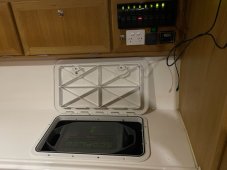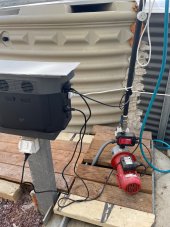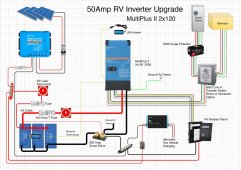AllByteNoBark
New Member
Hello, new here and new to solar stuff. I am fairly handy and know enough to be dangerous I guess. Looking for some help on the start to an expandable system for an RV.
We have a 5th wheel RV that came with a Xantrex X 2000 inverter, and a WFCO WF-9855-AD Deck Mount Converter Charger. It also came with two 85AH lead batteries. It is supposedly "solar ready" which kind of looks like a joke to me as far as wiring from the roof, light gauge and 20 amp fuse on it. A quick audit is showing around 3.5 to 4.0kWh of power used per day for our type of use. No air conditioning, residential fridge, laptop, Starlink, lights, water pump, and LP furnace with temps running in the 40s. I am hoping to get so I can run a couple of days off battery in cloudy conditions. We do carry a generator but would like to use it as backup only.
Would like to keep this simple to start with. Thought about a 24v or 48v system but the auto level is a pretty heavy load so am thinking maybe I should stick with 12v for simplicity. Also everything can be in close proximity so the heavier gauge wiring the 12v requires does not hurt quite so badly.
My thought was to get 2 x 12v 400AH batteries to replace the lead batteries. Have not got the roof measured yet for panels but would plan on adding them in two or three of months when I have a bit more time. The Xantrex will work for us for now. Not sure on the charger, do not want to harm batteries trying to save a few dollars, thoughts?
I just do not know what I do not know. Any helpful insight would be appreciated.
Thanks in advance!
We have a 5th wheel RV that came with a Xantrex X 2000 inverter, and a WFCO WF-9855-AD Deck Mount Converter Charger. It also came with two 85AH lead batteries. It is supposedly "solar ready" which kind of looks like a joke to me as far as wiring from the roof, light gauge and 20 amp fuse on it. A quick audit is showing around 3.5 to 4.0kWh of power used per day for our type of use. No air conditioning, residential fridge, laptop, Starlink, lights, water pump, and LP furnace with temps running in the 40s. I am hoping to get so I can run a couple of days off battery in cloudy conditions. We do carry a generator but would like to use it as backup only.
Would like to keep this simple to start with. Thought about a 24v or 48v system but the auto level is a pretty heavy load so am thinking maybe I should stick with 12v for simplicity. Also everything can be in close proximity so the heavier gauge wiring the 12v requires does not hurt quite so badly.
My thought was to get 2 x 12v 400AH batteries to replace the lead batteries. Have not got the roof measured yet for panels but would plan on adding them in two or three of months when I have a bit more time. The Xantrex will work for us for now. Not sure on the charger, do not want to harm batteries trying to save a few dollars, thoughts?
I just do not know what I do not know. Any helpful insight would be appreciated.
Thanks in advance!





